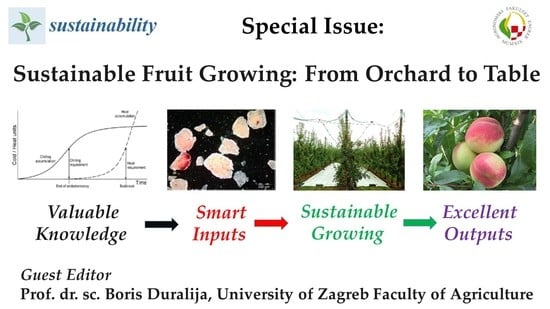Sustainable Fruit Growing: From Orchard to Table-Editorial Commentary
- Sustainable Fruit Growing: From Orchard to Table-Editorial Comentary
- Innovative Strategies for the Use of Reflective Foils for Fruit Colouration to Reduce Plastic Use in Orchards [6]
- Detecting Apples in the Wild: Potential for Harvest Quantity Estimation [7]
- Interpreting Environmental Impacts Resulting from Fruit Cultivation in a Business Innovation Perspective [8]
- Chilling and Heat Accumulation of Fruit and Nut Trees and Flower Bud Vulnerability to Early Spring Low Temperatures in New Mexico: Meteorological Approach [9]
- Polyphenol-Based Microencapsulated Extracts as Novel Green Insecticides for Sustainable Management of Polyphagous Brown Marmorated Stink Bug (Halyomorpha halys Stål, 1855) [10]
- Evaluation of the Characteristics of the Native Wild Himalayan Fig (Ficus palmata Forsk.) from Pakistan as a Potential Species for Sustainable Fruit Production [12]
- Main Agro-Morphological and Biochemical Berry Characteristics of Wild-Grown Sea Buckthorn (Hippophae rhamnoides L. ssp. caucasica Rousi) Genotypes in Turkey [13]
- Sustainable Cornelian Cherry Production in Montenegro: Importance of Local Genetic Resources [14]
- Assessment of Morphological Traits, Nutritional and Nutraceutical Composition in Fruits of 18 Apricot cv. Sekerpare Clones [15]
- Determination of Selected Beneficial Substances in Peach Fruits [16]
Funding
Institutional Review Board Statement
Informed Consent Statement
Data Availability Statement
Conflicts of Interest
References
- Bursać Kovačević, D.; Brdar, D.; Fabečić, P.; Barba, F.J.; Lorenzo, J.M.; Putnik, P. Strategies to achieve a healthy and balanced diet: Fruits and vegetables as a natural source of bioactive compounds. In Agri-Food Industry Strategies for Healthy Diets and Sustainability; Academic Press: Cambridge, MA, USA, 2020; pp. 51–88. [Google Scholar]
- Lam, D. How the World Survived the Population Bomb: Lessons From 50 Years of Extraordinary Demographic History. Demography 2011, 48, 1231–1262. [Google Scholar] [CrossRef] [Green Version]
- Food and Agriculture Organization of the United Nations (FAO). Available online: http://www.fao.org/faostat/en/ (accessed on 11 January 2022).
- Reganold, J.P.; Glover, J.D.; Andrews, P.K.; Hinman, H.R. Sustainability of three apple production systems. Nature 2001, 410, 926–930. [Google Scholar] [CrossRef]
- Duralija, B.; Putnik, P.; Brdar, D.; Bebek Markovinović, A.; Zavadlav, S.; Pateiro, M.; Domínguez, R.; Lorenzo, J.M.; Bursać Kovačević, D. The Perspective of Croatian Old Apple Cultivars in Extensive Farming for the Production of Functional Foods. Foods 2021, 10, 708. [Google Scholar] [CrossRef] [PubMed]
- Hess, P.; Kunz, A.; Blanke, M.M. Innovative Strategies for the Use of Reflective Foils for Fruit Colouration to Reduce Plastic Use in Orchards. Sustainability 2020, 13, 73. [Google Scholar] [CrossRef]
- Janowski, A.; Kaźmierczak, R.; Kowalczyk, C.; Szulwic, J. Detecting Apples in the Wild: Potential for Harvest Quantity Estimation. Sustainability 2021, 13, 8054. [Google Scholar] [CrossRef]
- Medici, M.; Canavari, M.; Toselli, M. Interpreting Environmental Impacts Resulting from Fruit Cultivation in a Business Innovation Perspective. Sustainability 2020, 12, 9793. [Google Scholar] [CrossRef]
- Djaman, K.; Koudahe, K.; Darapuneni, M.; Irmak, S. Chilling and Heat Accumulation of Fruit and Nut Trees and Flower Bud Vulnerability to Early Spring Low Temperatures in New Mexico: Meteorological Approach. Sustainability 2021, 13, 2524. [Google Scholar] [CrossRef]
- Živković, I.P.; Jurić, S.; Vinceković, M.; Galešić, M.A.; Marijan, M.; Vlahovićek-Kahlina, K.; Mikac, K.M.; Lemic, D. Polyphenol-Based Microencapsulated Extracts as Novel Green Insecticides for Sustainable Management of Polyphagous Brown Marmorated Stink Bug (Halyomorpha halys Stål, 1855). Sustainability 2020, 12, 10079. [Google Scholar] [CrossRef]
- Li, H.; Bolarić, S.; Vokurka, A.; He, J.; Wang, D.; Li, X.; Mešić, A.; Wang, J.; Duralija, B. Genetic Variability and Structure of Fragaria nilgerrensis Schlecht. Germplasm in Sichuan Province. Horticulturae 2021, 7, 353. [Google Scholar] [CrossRef]
- Khan, M.R.; Khan, M.A.; Habib, U.; Maqbool, M.; Rana, R.M.; Awan, S.I.; Duralija, B. Evaluation of the Characteristics of Native Wild Himalayan Fig (Ficus palmata Forsk.) from Pakistan as a Potential Species for Sustainable Fruit Production. Sustainability 2022, 14, 468. [Google Scholar] [CrossRef]
- Ilhan, G.; Gundogdu, M.; Karlović, K.; Židovec, V.; Vokurka, A.; Ercişli, S. Main Agro-Morphological and Biochemical Berry Characteristics of Wild-Grown Sea Buckthorn (Hippophae rhamnoides L. ssp. caucasica Rousi) Genotypes in Turkey. Sustainability 2021, 13, 1198. [Google Scholar] [CrossRef]
- Jaćimović, V.; Božović, D.; Ercisli, S.; Bosančić, B.; Necas, T. Sustainable Cornelian Cherry Production in Montenegro: Importance of Local Genetic Resources. Sustainability 2020, 12, 8651. [Google Scholar] [CrossRef]
- Karatas, N.; Ercisli, S.; Bozhuyuk, M.R. Assessment of Morphological Traits, Nutritional and Nutraceutical Composition in Fruits of 18 Apricot cv. Sekerpare Clones. Sustainability 2021, 13, 11385. [Google Scholar] [CrossRef]
- Mrázová, M.; Rampáčková, E.; Šnurkovič, P.; Ondrášek, I.; Nečas, T.; Ercisli, S. Determination of Selected Beneficial Substances in Peach Fruits. Sustainability 2021, 13, 14028. [Google Scholar] [CrossRef]
- Ondrašek, G.; Romić, D.; Romić, M.; Duralija, B.; Mustač, I. Strawberry growth and fruit yield in a saline environment. Agric. Conspec. Sci. 2006, 71, 155–158. [Google Scholar]
- Klamkowski, K.; Treder, W. Morphological and physiological responses of strawberry plants to water stress. Agric. Conspec. Sci. 2006, 71, 159–165. [Google Scholar]
- Miličević, T.; Ivić, D.; Cvjetković, B.; Duralija, B. Possibilities of Strawberry Integrated Disease Management in Different Cultivation Systems. Agric. Conspec. Sci. 2006, 71, 129–134. [Google Scholar]
Publisher’s Note: MDPI stays neutral with regard to jurisdictional claims in published maps and institutional affiliations. |
© 2022 by the author. Licensee MDPI, Basel, Switzerland. This article is an open access article distributed under the terms and conditions of the Creative Commons Attribution (CC BY) license (https://creativecommons.org/licenses/by/4.0/).
Share and Cite
Duralija, B. Sustainable Fruit Growing: From Orchard to Table-Editorial Commentary. Sustainability 2022, 14, 1053. https://0-doi-org.brum.beds.ac.uk/10.3390/su14031053
Duralija B. Sustainable Fruit Growing: From Orchard to Table-Editorial Commentary. Sustainability. 2022; 14(3):1053. https://0-doi-org.brum.beds.ac.uk/10.3390/su14031053
Chicago/Turabian StyleDuralija, Boris. 2022. "Sustainable Fruit Growing: From Orchard to Table-Editorial Commentary" Sustainability 14, no. 3: 1053. https://0-doi-org.brum.beds.ac.uk/10.3390/su14031053





